Game Changers: How Oscar Robertson Led His High School to a Barrier-Breaking State Title

Adapted from THE REAL HOOSIERS: Crispus Attucks High School, Oscar Robertson and the Hidden History of Hoops by Jack McCallum. Copyright © 2024 by the author and reprinted by permission of Hachette Books. All rights reserved.
For decades, a Catch-22 rule by the Indiana State Athletic Association prevented segregated schools, including Catholic ones, from competing in its storied high school basketball tournament. (Never mind that Crispus Attucks High in Indianapolis was segregated because the school board had mandated construction of a school for African Americans.) The discriminatory policy ended in the 1940s. But it wasn’t until 1955 that an all-Black high school made the final game.
In fact, two of them did. On the Monday before Super Saturday at Butler Fieldhouse on March 19, 1955, the day when the four remaining teams would play for the state championship, a meeting was convened at the office of Indianapolis mayor Alex M. Clark. The principal of Attucks, Dr. Russell Lane, was there, along with at least one representative from the police department, the fire chief and a couple of downtown businessmen (all white). It appears that the school superintendent, Dr. Herman L. Shibler, attended, but if not, he was certainly monitoring the proceedings.
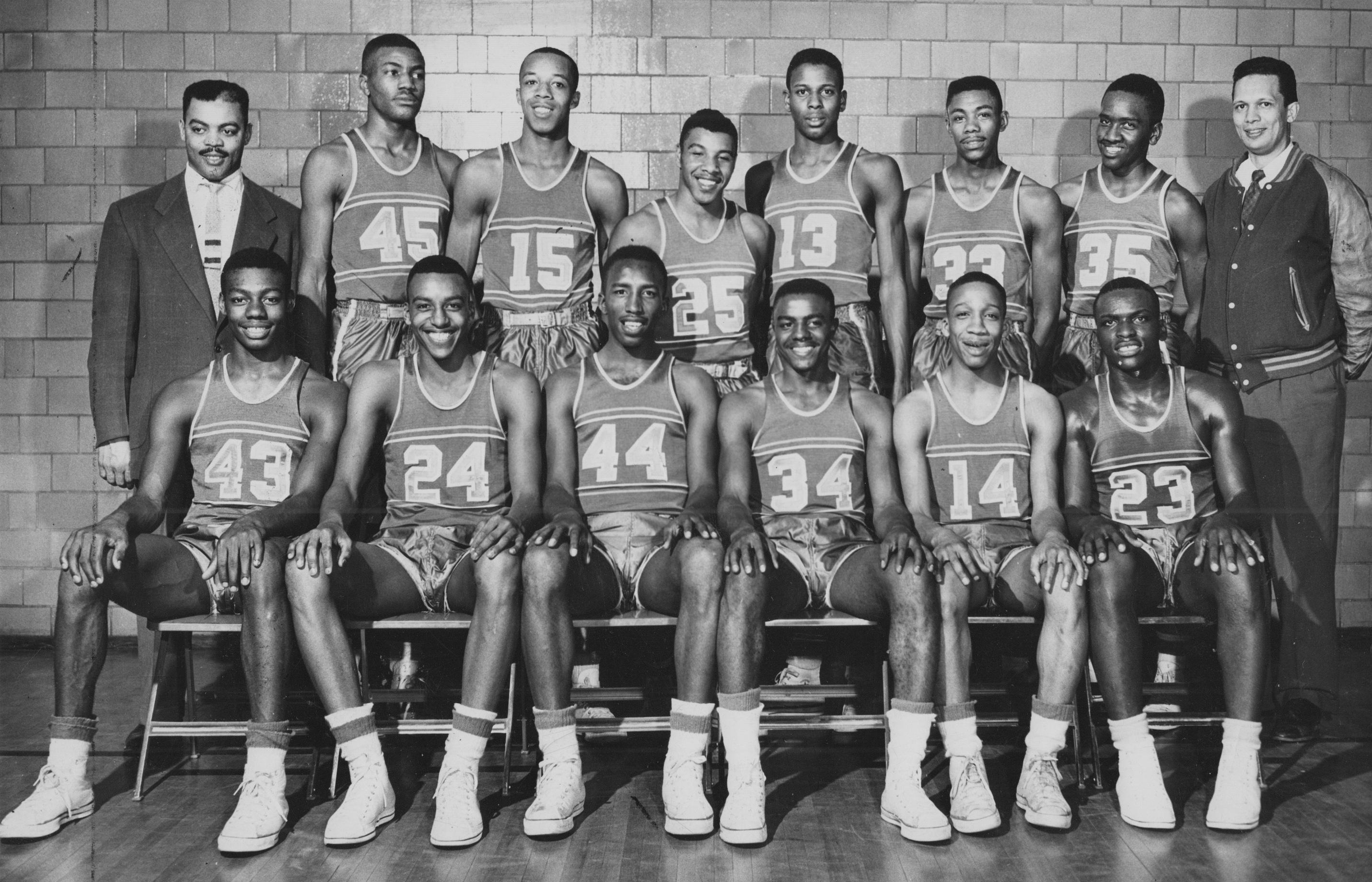
The stated purpose of the meeting was to discuss celebration plans if Attucks won the state title, which now seemed, in the minds of most prognosticators, a fait accompli. The tenor of the discussion, as well as some of the specifics, remains unclear—which is a shame because that meeting serves as a fascinating backdrop to what would be the most glorious weekend in the three-decade life of Crispus Attucks High.
Consider the multitude of factors that were in play during that landmark week in March 1955:
- Attucks was set to be not only the first Black state championship team but also the first team from Indianapolis to win it all.
- Its opponent in the final was expected to be another all-Black team, Roosevelt High from Gary. That meant 10 African Americans on the court for 32 minutes in an arena where Black players were still few and far between. The NBA barely had 10 African Americans in its nine-team league.
- Wafting around all of this was the memory of the previous year’s state championship celebration—dare we call it orgiastic?—after beloved Milan, the inspiration for the film Hoosiers three decades later, won it all. The police department had all but adopted the Milan team, giving it an escort around Monument Circle and stopping local traffic to honor a team from 80 miles outside Indianapolis.
- Amid the anticipation of victory, there floated a sense of unease in some segments of the white community, which had never engaged in wholesale racially integrated celebration. Indianapolis was still a deeply segregated town, and the city was not far from the days when Attucks victories produced stories about how the locals were whooping it up down on crazed Indiana Avenue. My God, what would the Ave-noo be like after a state championship win? And what if a Black boy asks a white girl to dance? Would the world remain on its axis?
It’s impossible to determine if any journalists sat in on the meeting in the mayor’s office, but all the Indy newspapers reported on it. A story in the Indianapolis Star took a downcast tone, bearing the headline ATTUCKS VICTORY PLANS LEAVE OUT FIRE TRUCK, and said that the championship might “lack one of the traditional thrills” that was a “time-honored salute to [Indiana High School Athletic Association] kings since basketballs had laces.”
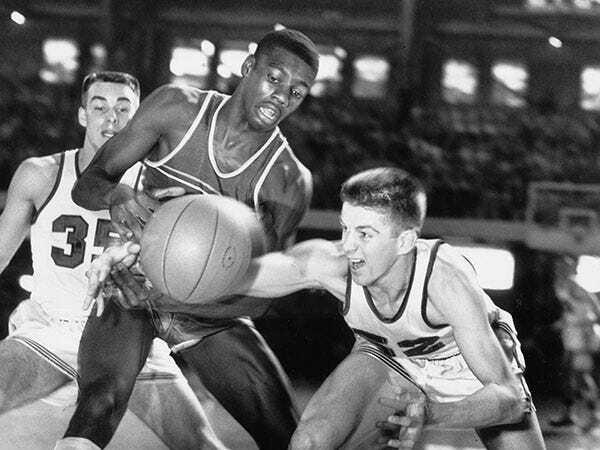
But reporting on the same meeting, the Indianapolis News related that fire chief Joseph Hancock promised Attucks “a gleaming fire truck” for the celebration. The Indianapolis Recorder said that Attucks could have “the shiniest fire truck in town” if it won, and the Star, contradicting its earlier story, even laid out specifics: Lane, Shibler and Clark would ride in the mayor’s Cadillac, followed by the coaches and players on a city fire truck, in turn followed by buses for Attucks students.
In other words, it was to be a citywide party, likely the first time a group of African Americans would be recognized by the masses.
But years later, Lane had a different take on what transpired. Ted Green, who wrote and directed a 2016 documentary about Attucks, found an audiotape of Lane talking about the meeting and included it in his documentary. Here’s what Lane said:
When we were about to win that championship, the week before they called me down to the school office. The superintendent did—Dr. Shibler. He had the fire chief down there and the police chief and representatives of businessmen downtown. Sitting around the table. Called me and said, “Mr. Lane, it looks like your team’s going to win the championship next Saturday night. The merchants downtown are frightened that after you win that championship, colored people will come downtown and tear up the downtown. Break out the windows and knock out the streetlights, and all that.” I said I don’t believe they would do one thing.
Narrator Green then paraphrases what Lane said he was told: The parade could include one lap around Monument Circle but would then have to move to the west side of town, to Northwestern Park deep in the Black neighborhood. The message was clear: Arguably the grandest moment in Indianapolis sports history would be diminished because it was achieved by African Americans.
Lane spent much of the week reminding the Attucks team and the students that they needed to behave themselves. But how much reminding did they need? In recent years no team had comported itself as well as Attucks. Earlier in the season, Forest Witsman, the coach of bitter intracity rival Howe, had made this comment: “My kids would rather play Attucks than any team I know. They’re gentlemen.”
Whatever happened in the mayor’s office was of little concern to Oscar Robertson and his teammates. No doubt they understood the larger significance of being the first all-Black team on such a big stage, but it’s doubtful they dug into the parade details and celebration specifics. They were kids. They wanted to win, collect the trophy and kiss the girls.
The Recorder had teased this moment a year earlier when Attucks and Roosevelt were advancing in the postseason. “It looks like the folks better hurry up and abolish segregated schools for sure,” the paper wrote, “if they don’t want to be looking at an all-tan final game of these go-rounds.” Attucks reached the state semis while Roosevelt lost in the regionals in 1954. But, as was predicted, the go-round of ’55 was here, and the Recorder recognized the moment. In the days preceding the state championship foursome at Butler, the weekly ran a story about a man named Fred K. Dale of Pendleton, Ind., a small town about 30 miles northeast of Indianapolis. Dale told the Recorder that an Attucks victory “should do much to remove the last traces” of Jim Crow laws. “The old tale of Negro inferiority will be dealt a severe blow by an Attucks victory this week. The double-barreled attack, with Gary Roosevelt in the North, should convince even the hardest headed that the days of segregation and second-rate living are gone forever. In case you have forgotten, I am a white man. Not all of us are KKK supporters.”
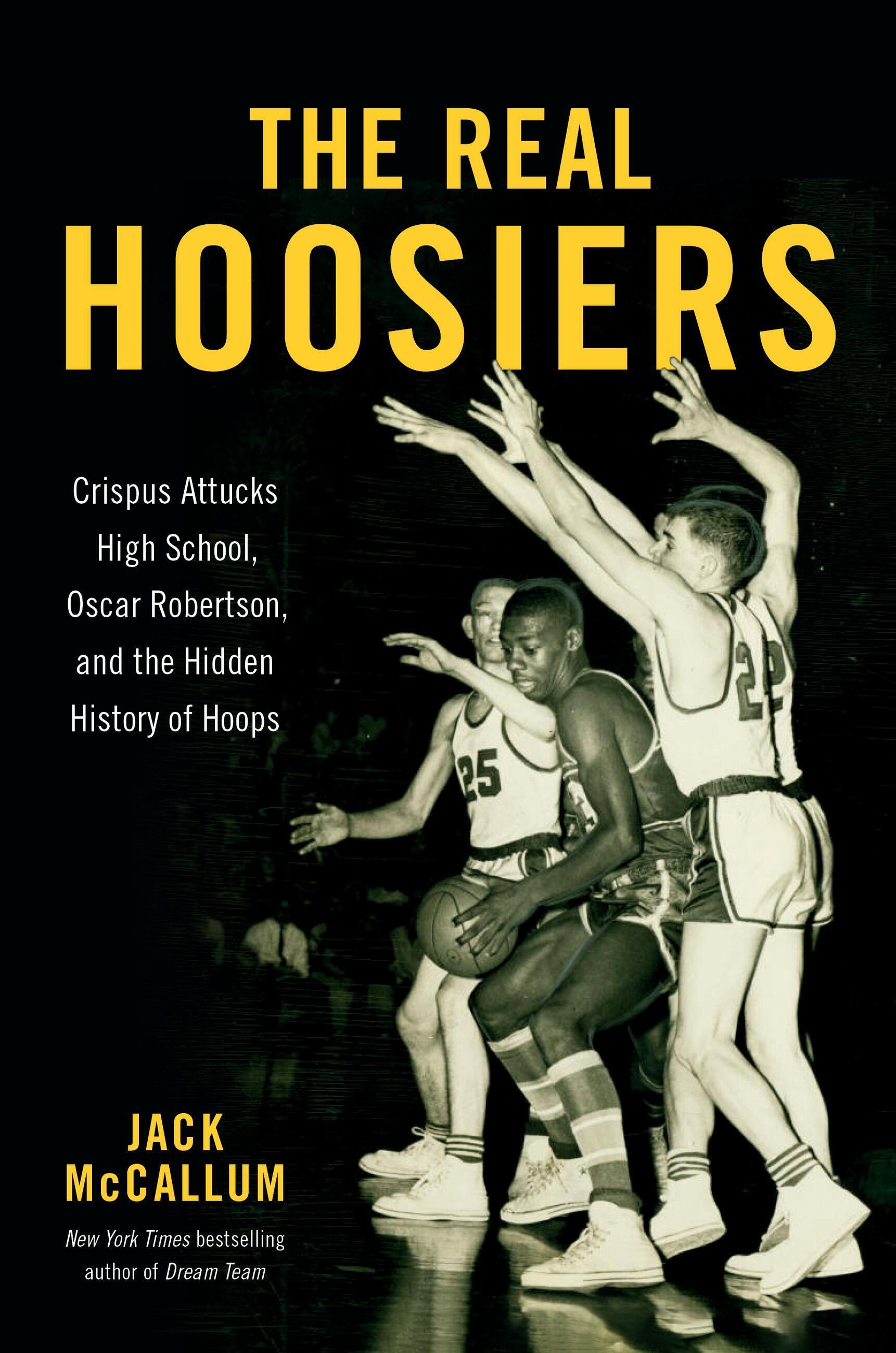
In retrospect, it’s difficult to understand why Roosevelt, which would play Fort Wayne North in the second semifinal, following Attucks–New Albany, didn’t get more attention as a potential state champion. They had lost only two games and featured the state’s likely Mr. Basketball, Wilson “Jake” Eison, a 6’ 5” interior player (only seniors could be Mr. Basketball, or Oscar, a junior, might have won it), as well as Dick Barnett, an unorthodox southpaw who would have a 15-year pro career that included two championship rings with the New York Knicks.
The biographies of the Roosevelt players closely matched those of their opponents. They too were children of the Great Migration, their childhood expectations not much beyond landing a job in the Gary steel mills. Basketball was their salvation. Barnett’s family came north from Alabama, and his parents separated in Gary. “My learning and inspiration came from sports, which really changed my life,” said Barnett.
Most of the local prognosticators were picking Attucks (OUR GALLOP POLL: IT’S ATTUCKS punned the Recorder) with New Albany, the Tigers’ opponent in the afternoon, the second pick. W. F. Fox Jr., sports editor of the Indianapolis News and the undisputed dean of doggerel, put it this way:
But we’re saluting Attucks
In Attucks we rejoice.
And you will understand, of course,
That Attucks is our choice.
With Robertson and Hampton,
With Merriweather, Scott
With Mitchell, Brown and others,
A triumph we would plot.
Rough the road, supreme the test
For those who win the crown
May Attucks wear the golden rings
Here in the old hometown.
No Pulitzer was forthcoming for Fox, but consider: An old-school Caucasian sportswriter was lauding an all-Black team, rooting them on, connecting them to “the old hometown.” This was a new path.
Though Robertson would say 50 years after the game that Attucks didn’t play well in the afternoon opener—“If New Albany had possessed half of our talent,” he wrote in his autobiography, The Big O, “we would’ve been in serious trouble”—a perusal of the game indicates that Attucks was never in real danger of losing. A fourth-period explosion from Oscar (two straight baskets and two free throws) propelled Attucks, which opened up a 78–63 lead with two minutes left. The final was 79–67.
A film of the great Attucks team of 1951 (Hallie Bryant, Willie Gardner, Flap Robertson) on one side of a screen juxtaposed with the 1955 team (Oscar Robertson, Willie Merriweather, Sheddrick Mitchell) on the other would reveal how important Attucks was to basketball’s evolution in that pivotal time between the early and mid-1950s. To a large extent, those early-1950s teams were a palimpsest for the Oscar teams that followed. Sure, there were still vestiges of the old game in 1955. Merriweather, a smooth, athletic forward, who made an incredible 70% of his field goal attempts in his senior year, shot an overhead two-handed set that looked like it came out of the 1930s. Mitchell put up the kind of sweeping hook that pivotmen at all levels of the game were using back in the 1950s. Even Oscar never really did shoot a classic jumper. He held the ball high with one hand, like a waiter carrying a trayful of food, and shot it with deliberation. Then again, so what? He got it off, and it went in.
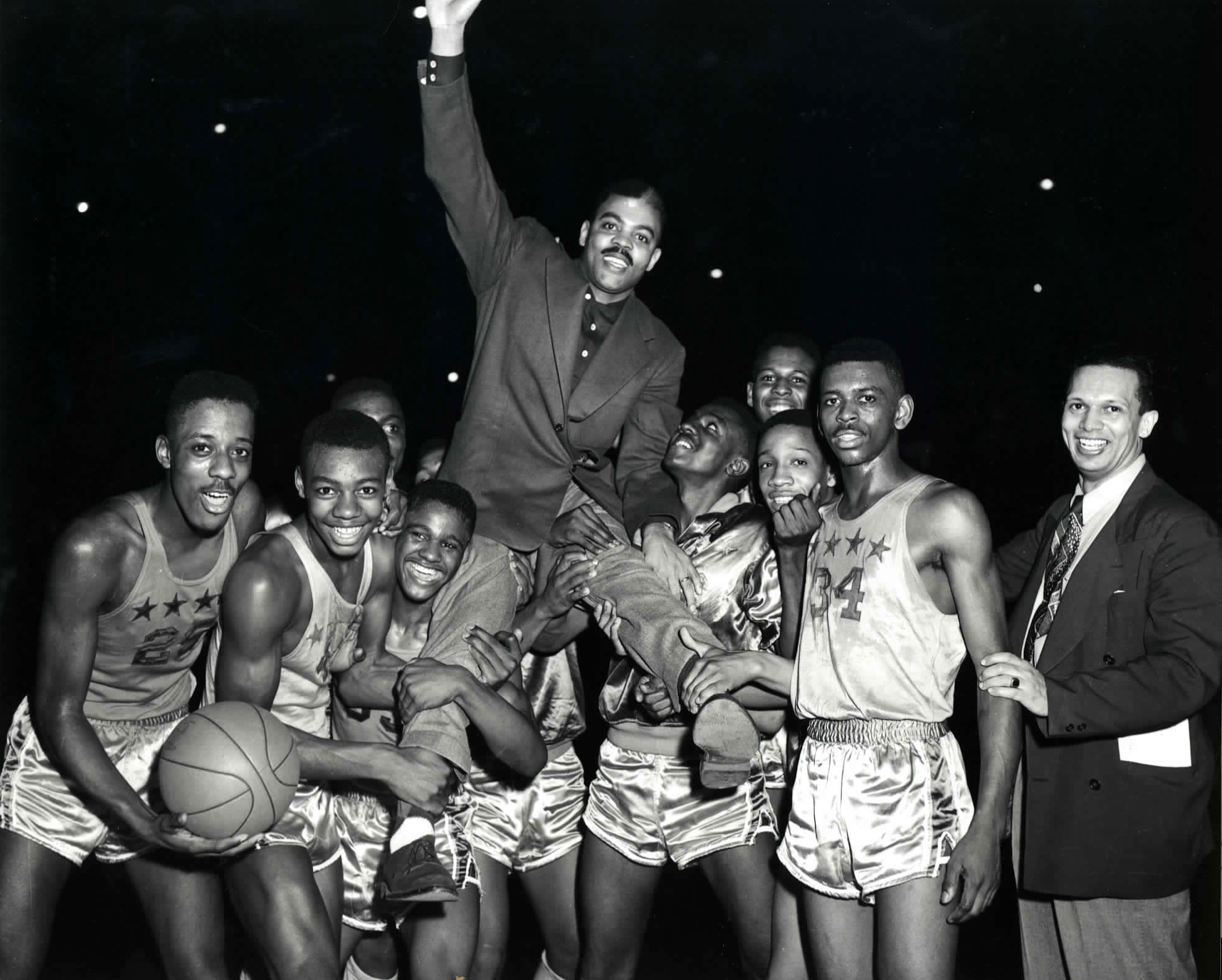
But other parts of the game obviously signal the beginning of a new era. Against New Albany, coach Ray Crowe had Attucks amp up the defensive pressure, forcing the opponent to play a tempo with which it wasn’t comfortable. That went against the seeming gentlemen’s agreement not to apply intense pressure that was in vogue even with Crowe’s early Attucks teams. Similarly, Oscar was one of the few players to “dig” at a center when the center got the ball with his back to the basket, making it difficult for the offensive player to move even if it didn’t result in a turnover. He continued to do that in the NBA. (Like many great players—Magic Johnson, Larry Bird and Julius Erving among them—Oscar wasn’t nearly as interested in lockdown defending as he was in getting steals off the ball.)
On the offensive end, Attucks changed the way the game looked by taking away its stationary aspect. Perhaps because of the unaggressive defense of the era, passes were highly predictable, lacking creativity. Guard throws it to the wing. Wing enters it to the pivot, who stands with his back to the basket. Maybe somebody cuts, splits the pivot, maybe not. There was a lot of standing around. (Though, to be fair, there’s a lot of standing around during contemporary NBA isolation plays, too.)
But by Oscar’s junior year, Attucks moved the ball quicker. It happened in part because, though Oscar dribbled a lot, he didn’t overdribble. “He always went someplace with his dribble,” says Carl Short, an all-city player at Indianapolis Emmerich Manual in 1955–56. “He could go either way, and he had a way of keeping you from getting it, sort of an arm bar. He didn’t do anything in a fancy way, just an efficient way.”
The whole Attucks team, particularly Robertson, grew more adept at hitting Mitchell and Merriweather when they were on the move. Was that Crowe getting more innovative or Crowe having Oscar? Probably some of both. Robertson penetrated and, if stopped, looked inside to Mitchell or Merriweather. He made decisions in the air, which had not been part of the early-1950s game.
The starkest distinction between the two “eras” (even though they’re only four years apart) is in ball handling. Even skillful players such as Bryant—the forward was later, after all, a Harlem Globetrotter—didn’t look completely comfortable with the bounce. Most players still dribbled with their right hand when they went left, and there was a lot of “defensive dribbling” (i.e., handling the ball carefully with the main objective being not to lose it instead of to initiate offense). By and large the 1954–55 Tigers moved smoothly in either direction, and it’s beyond obvious to state that Oscar was the big reason.
Robertson remembers an unusual atmosphere at Butler Fieldhouse before the final. Years later he waxed bitterly about it in The Big O: “While the teams were warming up, I remember the crowd being silent. Could it have been because there were no white players on either team? Because Indiana’s legendary cultured and diehard basketball fans were not all that excited about sitting there and watching Black players, Black coaches and Black student managers? Because maybe they were worried about us racial interlopers kidnapping their beloved game.”
But elsewhere in Indianapolis there was much excitement. The police department ordered up six extra television sets so every officer on duty could watch, and on the other side of the law, prisoners in the Marion County Jail watched on three sets.
The game began with an Oscar jump shot that was so predictable Robertson should have grabbed the PA mic before tip-off and announced, Ladies and gentlemen. Here’s what’s going to happen. I control the opening tip, get the ball back, dribble deliberately to the right elbow, where I will shoot a jumper over my defender, whoever he may be, and there’s not a damn thing anyone can do about it.
Every Attucks game did not begin with that scenario, but, as time went on, the Tigers did it more and more. More accurately, Oscar did it. Crowe didn’t call the play. It was a scene setter, a sign of things to come, a statement with a capital O. That’s how the 1955 Indiana state championship game began. Oscar converted the shot for a score of 2–0.
It was 51–32 at halftime, and sensing blood, Attucks applied full-court pressure in the third period. And then it was over. The final score was 97–74. Good thing Attucks stopped scoring when it did because the old-school scoreboard could not register three digits.
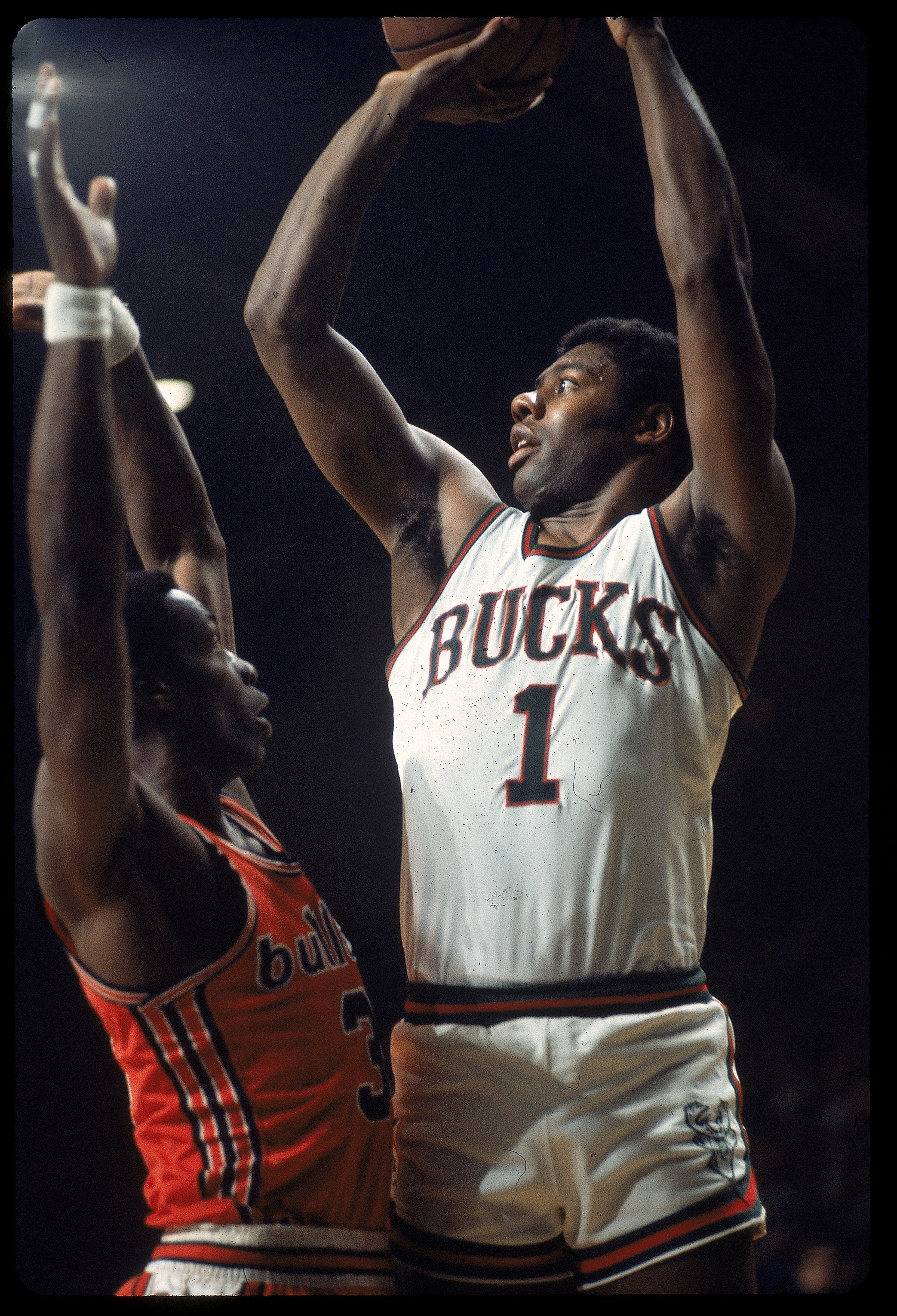
The game may have matched two Black teams, but they seemed to have little in common, at least no more than any two teams involved in a rout. Attucks played with confidence, Roosevelt with reticence. When Attucks did slow down on offense, it seemed to have a plan, while Roosevelt flailed. Merriweather says he used to laugh when he heard about Phil Jackson’s triangle offense with the Chicago Bulls and Los Angeles Lakers “because we were playing it back then, throwing it into the post and cutting off it.”
Barnett, who had three fouls by early in the second period, played more of a one-on-one game, though he did convert a couple of those unorthodox, legs-flared-at-all-angles southpaw jumpers that would define his style in the pros. He finished with 18 points but wasn’t much of a factor. A few years later, two Attucks players, Bill Brown and Stanford Patton, were Barnett’s teammates at Tennessee Agricultural & Industrial, the historically Black college coached by John McLendon that later became Tennessee State University. “I knew you were good,” Barnett told them, “but there’s no way I thought you would put that kind of beatin’ on us.”
The “point forward” position became a major topic of conversation in the 1980s and ’90s, with tall players like Paul Pressey and Lamar Odom coming to the backcourt to initiate the offense. But one could argue that Robertson debuted the position in the mid-1950s. Look, great players are always going to get the ball. But Oscar really played the position. He was listed as a forward because that’s the way it was back then: Tallest is the center, next tallest are forwards, smallest two are guards. But the 6' 3" Oscar jumped center, took the first shot, spent the early minutes of the game underneath, then, inevitably, came back to take control of the ball. Crowe didn’t have to tell him, and the guards, usually Bill Hampton and Bill Scott, weren’t going to argue. By the third period, Oscar simply headed for the backcourt, got the ball, and directed the offense. 1950s, meet the early incarnation of LeBron James.
One play in the second period is illustrative of how far Attucks basketball, and Robertson in particular, had come. Oscar gives a long lead pass to Merriweather that no one is even aware he is throwing. Before anyone can react, Oscar cuts to the basket, gets a return pass, and lays it in. He is perhaps a little too one way (i.e., he favors his right hand by a good bit). But so was Jerry West, and no one stopped him either.
The big difference between the teams was obvious. “We had Oscar, and they didn’t,” says Merriweather today. “I know it sounds simple, but it’s the truth. You could not guard him—they couldn’t guard him in the pros either—and he was tough and smart. No one was close to him back then.”
Fox’s postgame column praised the sportsmanship shown by Crowe and his team, and it was deserved. Consider this unforgettable moment from the game: Merriweather knocks down Barnett on a breakaway, and a foul is called. Merriweather first walks away, thinks about it, then runs back to offer Barnett a hand. “Don’t touch me, motherf-----,” is what Merriweather says Barnett said to him. Barnett then goes to the sideline, and Merriweather follows him, still concerned. Finally, Barnett comes back onto the court, and this time Barnett accepts Merriweather’s handshake. And remember that Merriweather was Attucks’s enforcer.
Competitively, Attucks had adopted a completely different mindset from the days of Crowe’s predecessor, Fitzhugh Lyons, who was reluctant to let an Attucks defender get too close to his man lest the physicality get too excessive. But the Tigers under Crowe, who himself had been overly timid at first, had by now figured out how to be both gentlemanly and ruthless.
And so, into the record books went the first Indiana state champion from the capital city and the first all-Black title team, quite likely the first all-Black team in the country to win a state championship. Eleven years later a team of all-Black starters from Texas Western College drubbed an all-white team from the University of Kentucky in the 1966 NCAA championship game. Hollywood made a movie out of it.
The title gave Crowe a five-year record of 123–14 to go with four sectional championships and four regional championships at a time when it was a safe bet that most basketball fans believed that a Black man didn’t have what it took to be a coach. It was like a metaphorical baton had been exchanged, the past giving way to the future, the moment set in stone by the handshake that the previous year’s winning coach, Milan’s Marvin Wood, gave to Crowe as he headed into the locker room.
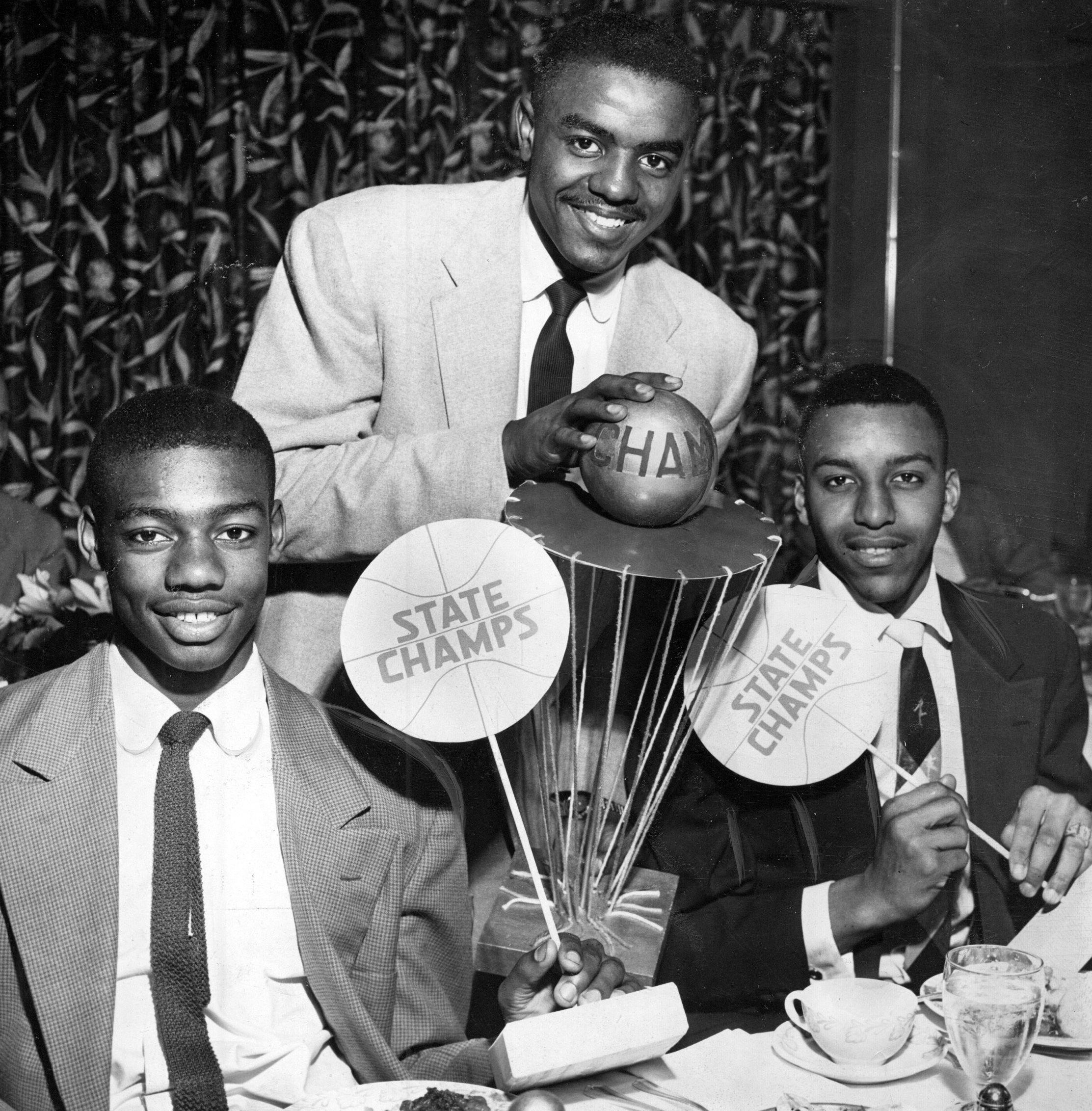
You wouldn’t have understood the cultural magnitude of the game had you listened to the broadcast (available on YouTube), because the announcer assiduously avoided mentioning skin tone. He could have edged into it by talking about the joint cheerleading squad that was put together, combining Attucks students with white kids, something that got a lot of play in the Indianapolis press. But we only see them for a fleeting moment.
But Attucks Nation understood the importance. Said Oscar, “It was the best, most pure feeling I’ve had in my life.”
And then, he says, it turned into one of the worst.
The postgame celebration—it was indeed one lap around Monument Circle, followed by the exodus to Northwestern Park—given to the Attucks team, perhaps the first time that white Hoosiers were in a position to cheer Black Hoosiers, remains a bone of contention for Oscar Robertson almost 70 years later, the subject of the following chapter.
